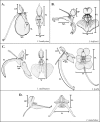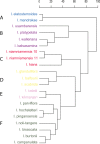A question of data quality-Testing pollination syndromes in Balsaminaceae
- PMID: 29036172
- PMCID: PMC5642891
- DOI: 10.1371/journal.pone.0186125
A question of data quality-Testing pollination syndromes in Balsaminaceae
Abstract
Pollination syndromes and their predictive power regarding actual plant-animal interactions have been controversially discussed in the past. We investigate pollination syndromes in Balsaminaceae, utilizing quantitative respectively categorical data sets of flower morphometry, signal and reward traits for 86 species to test for the effect of different types of data on the test patterns retrieved. Cluster Analyses of the floral traits are used in combination with independent pollinator observations. Based on quantitative data we retrieve seven clusters, six of them corresponding to plausible pollination syndromes and one additional, well-supported cluster comprising highly divergent floral architectures. This latter cluster represents a non-syndrome of flowers not segregated by the specific data set here used. Conversely, using categorical data we obtained only a rudimentary resolution of pollination syndromes, in line with several earlier studies. The results underscore that the use of functional, exactly quanitified trait data has the power to retrieve pollination syndromes circumscribed by the specific data used. Data quality can, however, not be replaced by sheer data volume. With this caveat, it is possible to identify pollination syndromes from large datasets and to reliably extrapolate them for taxa for which direct observations are unavailable.
Conflict of interest statement
Figures





Similar articles
-
Evolution of pollination syndromes and corolla symmetry in Balsaminaceae reconstructed using phylogenetic comparative analyses.Ann Bot. 2021 Jan 7;127(2):267-280. doi: 10.1093/aob/mcaa184. Ann Bot. 2021. PMID: 33091107 Free PMC article.
-
Nectar traits differ between pollination syndromes in Balsaminaceae.Ann Bot. 2019 Sep 24;124(2):269-279. doi: 10.1093/aob/mcz072. Ann Bot. 2019. PMID: 31120478 Free PMC article.
-
Breeding systems in Balsaminaceae in relation to pollen/ovule ratio, pollination syndromes, life history and climate zone.Plant Biol (Stuttg). 2019 Jan;21(1):157-166. doi: 10.1111/plb.12905. Epub 2018 Sep 24. Plant Biol (Stuttg). 2019. PMID: 30134002
-
Radiation of pollination systems in the Iridaceae of sub-Saharan Africa.Ann Bot. 2006 Mar;97(3):317-44. doi: 10.1093/aob/mcj040. Epub 2005 Dec 23. Ann Bot. 2006. PMID: 16377653 Free PMC article. Review.
-
The genetic architecture of natural variation in flower morphology.Curr Opin Plant Biol. 2011 Feb;14(1):60-5. doi: 10.1016/j.pbi.2010.09.012. Epub 2010 Oct 8. Curr Opin Plant Biol. 2011. PMID: 20934369 Review.
Cited by
-
Pre- and postzygotic mechanisms preventing hybridization in co-occurring species of the Impatiens purpureoviolacea complex.Ecol Evol. 2021 Nov 24;11(23):17485-17495. doi: 10.1002/ece3.8382. eCollection 2021 Dec. Ecol Evol. 2021. PMID: 34938523 Free PMC article.
-
Pollination biology of Impatiens capensis Meerb. in non-native range.PLoS One. 2024 Jun 20;19(6):e0302283. doi: 10.1371/journal.pone.0302283. eCollection 2024. PLoS One. 2024. PMID: 38900825 Free PMC article.
-
Seed morphology and sculpture of invasive Impatiens capensis Meerb. from different habitats.PeerJ. 2020 Nov 18;8:e10156. doi: 10.7717/peerj.10156. eCollection 2020. PeerJ. 2020. PMID: 33240597 Free PMC article.
-
Adaptation to pollination by fungus gnats underlies the evolution of pollination syndrome in the genus Euonymus.Ann Bot. 2023 Oct 18;132(2):319-333. doi: 10.1093/aob/mcad081. Ann Bot. 2023. PMID: 37610846 Free PMC article.
-
The predictive power of pollination syndromes: Passerine pollination in heterantherous Meriania macrophylla (Benth.) Triana (Melastomataceae).Ecol Evol. 2021 Sep 22;11(20):13668-13677. doi: 10.1002/ece3.8140. eCollection 2021 Oct. Ecol Evol. 2021. PMID: 34707808 Free PMC article.
References
-
- Kölreuter JG (1761) Vorläufige Nachrichten von einigen das Geschlecht der Pflanzen betreffenden Versuchen und Beobachtungen. Gleditschischen Handlung, Leipzig.
-
- Sprengel CK (1793) Das entdeckte Geheimnis der Natur im Bau und in der Befruchtung der Blumen. Vieweg, Berlin.
-
- Müller H (1883) The Fertilization of Flowers. Transl. Thompson D’Arcy W. Macmillan, London.
-
- Delpino F (1868–1875) Ulteriori osservazione sulla dicogamia nel regno vegetale. Atti Soc Ital Sci Nat, Mus Civ Stor Nat Milano, Vols. I and II.
MeSH terms
LinkOut - more resources
Full Text Sources
Other Literature Sources
Miscellaneous

